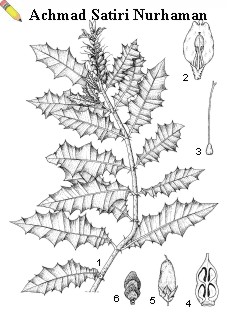Record Number
884
PROSEA Handbook Number
12(2): Medicinal and poisonous plants 2
Taxon
Acanthus ilicifolius L.
This article should be read together with the article on the genus: Acanthus in the Handbook volume indicated above in this database.
This article should be read together with the article on the genus: Acanthus in the Handbook volume indicated above in this database.
Protologue
Sp. pl. 2: 639 (1753).
Synonyms
Acanthus volubilis Wallich (1831).
Vernacular Names
Sea holly (En). Indonesia: jeruju (Sumatra), daruju (Javanese). Malaysia: jeruju, jeruju puteh (Peninsular). Philippines: daguari, diluariu (Tagalog), kasumba (Iloko). Papua New Guinea: kikia (Kavataria, Trobriand Island, Milne Bay Province). Thailand: kaem mo (peninsular), cha kreng (central), ngueak plaamo namngoen (general). Vietnam: [oo] r[oo], n[uw][ows]c, l[ax]o th[uwr] c[aa]n.
Distribution
Distributed from South India and Sri Lanka to Indo-China, Indonesia, the Philippines and northern Australia, but rather scarce in Malaysia.
Uses
The aerial parts of Acanthus ilicifolius are used as a poultice on wounds, and together with ginger, they are ground and put on sore legs, while a porridge from them is taken for bowel complaints. In Indonesia, a poultice of the leaves may be applied to treat rheumatic pain, or as an emollient. In Thailand, the stem and leaves are also used to promote longevity. In Papua New Guinea the leaves, crushed in water, are drunk to facilitate delivery. The solution can also be drunk before an operation.
Observations
A stout, erect or reclining shrub, up to 1.5 m tall, scarcely branched, glabrous, with adventitious aerial roots; leaves oblong, 6.5—11 cm x 4—6 cm; spike up to 16.5 cm long, dense or interrupted, bracts lanceolate, 10 mm long, bracteoles in 2 pairs, oblong-lanceolate, up to 1.5 cm long, calyx lobes obovate-oblong, ciliolate, corolla lobe obovate, 3 cm x 2.5 cm, pale to bright blue, corolla tube white. Acanthus ilicifolius is gregarious and very common along banks of estuaries and lagoons, and in marshy land and mangroves close to the seashore. It is rarely found inland.
Image
 | Acanthus ilicifolius L. - 1, flowering stem; 2, corolla with stamens and pistil; 3, pistil; 4, ovary in longitudinal section; 5, fruit; 6, seeds |
Selected Sources
[135] Burkill, I.H., 1966. A dictionary of the economic products of the Malay Peninsula. Revised reprint. 2 volumes. Ministry of Agriculture and Co-operatives, Kuala Lumpur, Malaysia. Vol. 1 (A—H) pp. 1—1240, Vol. 2 (I—Z) pp. 1241—2444.
[297] Farnsworth, N.R. & Bunyapraphatsara, N. (Editors), 1992. Thai medicinal plants. Medicinal Plant Information Center, Prachachon Co., Bangkok, Thailand. 402 pp.
[407] Heyne, K., 1950. De nuttige planten van Indonesië [The useful plants of Indonesia]. 3rd Edition. 2 volumes. W. van Hoeve, 's-Gravenhage, the Netherlands/Bandung, Indonesia. 1660 + CCXLI pp.
[579] Lakshmi, M., Rajalakshmi, S., Parani, M., Anuratha, C.S. & Parida, A., 1997. Molecular phylogeny of mangroves. I. Use of molecular markers in assessing the intraspecific genetic variability in the mangrove species Acanthus ilicifolius Linn. (Acanthaceae). Theoretical and Applied Genetics 94(8): 1121—1127.
[786] Perry, L.M., 1980. Medicinal plants of East and Southeast Asia. Attributed properties and uses. MIT Press, Cambridge, Massachusetts, United States & London, United Kingdom. 620 pp.
[838] A revised handbook to the flora of Ceylon (various editors), 1980—2000. Volume 1—9. Amerind Publishing Co., New Delhi, India. Volume 10—14. A.A. Balkema, Rotterdam, the Netherlands.
[867] Saralamp, P., Chuakul, W., Temsiririrkkul, R. & Clayton, T. (Editors), 1996. Medicinal plants in Thailand. Vol. I. Department of Pharmaceutical Botany, Faculty of Pharmacy, Mahidol University, Bangkok, Thailand. 219 pp.
[962] Srivatanakuk, P. & Naka, L., 1981. Effect of Acanthus ilicifolium Linn. in treatment of leukemic mice. Cancer Journal (Thailand) 27(3): 89—93.
[1069] Wijayakusuma, H.M.H., Dalimartha, S. & Wirian, A.S., 1994. Tanaman berkhasiat obat di Indonesia [Medicinal plants in Indonesia]. Vol. 3. Pustaka Kartini, Jakarta, Indonesia. 143 pp.
[297] Farnsworth, N.R. & Bunyapraphatsara, N. (Editors), 1992. Thai medicinal plants. Medicinal Plant Information Center, Prachachon Co., Bangkok, Thailand. 402 pp.
[407] Heyne, K., 1950. De nuttige planten van Indonesië [The useful plants of Indonesia]. 3rd Edition. 2 volumes. W. van Hoeve, 's-Gravenhage, the Netherlands/Bandung, Indonesia. 1660 + CCXLI pp.
[579] Lakshmi, M., Rajalakshmi, S., Parani, M., Anuratha, C.S. & Parida, A., 1997. Molecular phylogeny of mangroves. I. Use of molecular markers in assessing the intraspecific genetic variability in the mangrove species Acanthus ilicifolius Linn. (Acanthaceae). Theoretical and Applied Genetics 94(8): 1121—1127.
[786] Perry, L.M., 1980. Medicinal plants of East and Southeast Asia. Attributed properties and uses. MIT Press, Cambridge, Massachusetts, United States & London, United Kingdom. 620 pp.
[838] A revised handbook to the flora of Ceylon (various editors), 1980—2000. Volume 1—9. Amerind Publishing Co., New Delhi, India. Volume 10—14. A.A. Balkema, Rotterdam, the Netherlands.
[867] Saralamp, P., Chuakul, W., Temsiririrkkul, R. & Clayton, T. (Editors), 1996. Medicinal plants in Thailand. Vol. I. Department of Pharmaceutical Botany, Faculty of Pharmacy, Mahidol University, Bangkok, Thailand. 219 pp.
[962] Srivatanakuk, P. & Naka, L., 1981. Effect of Acanthus ilicifolium Linn. in treatment of leukemic mice. Cancer Journal (Thailand) 27(3): 89—93.
[1069] Wijayakusuma, H.M.H., Dalimartha, S. & Wirian, A.S., 1994. Tanaman berkhasiat obat di Indonesia [Medicinal plants in Indonesia]. Vol. 3. Pustaka Kartini, Jakarta, Indonesia. 143 pp.
Author(s)
H.C. Ong
Correct Citation of this Article
Ong, H.C., 2001. Acanthus ilicifolius L.. In: van Valkenburg, J.L.C.H. and Bunyapraphatsara, N. (Editors): Plant Resources of South-East Asia No 12(2): Medicinal and poisonous plants 2. PROSEA Foundation, Bogor, Indonesia. Database record: prota4u.org/prosea

All texts are licensed under a Creative Commons Attribution-Noncommercial-Share Alike 3.0 Netherlands License
This license does not include the illustrations (Maps,drawings,pictures); these remain all under copyright.